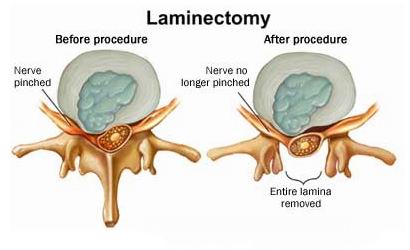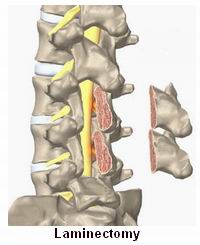
A laminectomy is a surgical procedure that involves the removal of a portion of the lamina, which is the bony covering of the spinal canal. This procedure is primarily performed to relieve pressure on the spinal cord or nerve roots caused by various spinal conditions such as spinal stenosis, herniated discs, tumors, or spinal arthritis. The goal of a laminectomy is to create more space in the spinal canal, which reduces pressure on the nerves and spinal cord, ultimately alleviating pain and other neurological symptoms.
The lamina forms part of the vertebrae and provides protection to the spinal cord. When pressure builds up due to narrowing of the spinal canal (spinal stenosis) or other conditions, it can cause severe pain, weakness, numbness, and loss of function in the affected areas. A laminectomy is usually considered when conservative treatments such as physical therapy, medications, or injections fail to provide relief.
Laminectomy can be performed on different regions of the spine, including the cervical, thoracic, and lumbar areas, depending on the location of the problem.

The need for a laminectomy is typically a result of various spinal conditions that cause narrowing of the spinal canal (spinal stenosis) or compression of the nerves. These conditions can develop due to a combination of age-related wear and tear, traumatic injury, or other underlying diseases.
1. Spinal Stenosis
Spinal stenosis is one of the most common reasons for undergoing laminectomy. It refers to the narrowing of the spinal canal, which can place pressure on the spinal cord or nerve roots, leading to pain, numbness, and weakness. Spinal stenosis often occurs in the lumbar spine (lower back) but can also affect the cervical spine (neck) and thoracic spine (upper back).
2. Herniated Disc
A herniated disc occurs when the inner material of a spinal disc (nucleus pulposus) leaks out of its outer casing (annulus fibrosus) and presses against nearby nerves. This can lead to pain, numbness, and weakness in the limbs. In some cases, a laminectomy is performed to remove the disc material and relieve nerve pressure.
3. Spinal Tumors
Benign or malignant tumors growing within or near the spinal cord can cause pressure on the spine, leading to neurological symptoms. If the tumor is located near the spinal canal, a laminectomy may be performed to remove the tumor and alleviate pressure.
4. Spinal Arthritis
Arthritis in the spine, often referred to as spondylosis, can lead to the formation of bone spurs, which can narrow the spinal canal and compress the spinal cord or nerves. Laminectomy is often recommended to remove these bone spurs and restore normal spinal function.
5. Trauma or Injury
Injury to the spine, such as from an accident or fall, can cause fractures, dislocations, or misalignments in the vertebrae. If the injury leads to compression of the spinal cord or nerves, a laminectomy may be required to remove the damaged tissue and restore spinal stability.
6. Risk Factors
Several factors can increase the risk of conditions that may require a laminectomy:
-
Age: Spinal conditions like degenerative disc disease, spinal stenosis, and arthritis become more common with age.
-
Genetics: A family history of spine problems or spinal stenosis can increase the risk.
-
Obesity: Excess weight places additional stress on the spine and may contribute to spinal degeneration.
-
Physical Activity: Jobs or activities that require heavy lifting, repetitive movements, or prolonged periods of standing can strain the spine and contribute to the development of conditions requiring laminectomy.
-
Previous Spine Injuries: A history of spine trauma or surgery increases the likelihood of developing conditions that may require surgery.
Patients who may benefit from a laminectomy typically experience symptoms caused by pressure on the spinal cord or nerves. These symptoms can vary depending on the location of the problem (cervical, thoracic, or lumbar spine) and may range from mild discomfort to severe disability.
1. Pain
The most common symptom that leads to the consideration of laminectomy is chronic pain. In cases of spinal stenosis, pain typically worsens with standing, walking, or bending. The pain may be felt in the neck (cervical stenosis), lower back (lumbar stenosis), or upper back (thoracic stenosis).
2. Radiating Pain
Radiating pain, often described as shooting or burning, may travel down the legs (in lumbar stenosis) or arms (in cervical stenosis). This pain occurs when nerve roots are compressed by the narrowing of the spinal canal or the presence of a herniated disc.
3. Numbness and Tingling
Numbness, tingling, or a sensation of pins and needles in the legs, feet, arms, or hands are common signs of nerve compression caused by spinal stenosis, herniated discs, or arthritis. This is often referred to as paresthesia and can lead to functional impairment in the affected limbs.
4. Weakness
Weakness in the legs or arms is another common symptom of nerve compression due to conditions like spinal stenosis or herniated discs. The weakness may affect mobility and balance, making it difficult to perform normal activities like walking, standing, or climbing stairs.
5. Loss of Reflexes
Compression of the spinal nerves can impair normal reflex activity. During a neurological exam, your doctor may test for reduced or absent reflexes in the legs or arms, which is a sign of nerve damage.
6. Difficulty Walking
As nerve compression increases, some individuals may experience difficulty walking or maintaining balance, particularly in lumbar stenosis or cervical stenosis. In more severe cases, this can result in instability or the need for walking aids.
7. Bowel or Bladder Dysfunction
In severe cases of spinal cord compression, cauda equina syndrome can develop, leading to loss of bowel or bladder control. This is a medical emergency that requires immediate surgical intervention.
A proper diagnosis is essential to determine if a laminectomy is needed. Your healthcare provider will conduct a thorough evaluation, including a detailed medical history, physical exam, and diagnostic imaging.
1. Physical Examination
Your doctor will perform a physical exam to assess your spinal range of motion, muscle strength, reflexes, and nerve function. The exam may include tests to check for pain, numbness, and weakness in the affected areas of the body.
2. Imaging Tests
-
X-rays: X-rays are typically the first imaging test used to assess the spine. They can help identify spinal misalignment, degenerative changes, and narrowing of the spinal canal.
-
MRI (Magnetic Resonance Imaging): MRI is the gold standard for evaluating the soft tissues of the spine, including discs, ligaments, and nerve roots. It provides detailed images and can reveal conditions like herniated discs, spinal stenosis, or tumors.
-
CT Scan (Computed Tomography): A CT scan provides detailed images of the bones in the spine and can help assess the severity of bone-related problems or complications related to previous surgeries.
-
Myelogram: A myelogram involves injecting a special dye into the spinal canal to improve the visibility of the spinal cord, nerve roots, and discs. This test is often combined with a CT scan.
Before deciding to undergo laminectomy surgery, patients typically try several non-surgical treatments to manage their symptoms. If these treatments are unsuccessful, surgery may be considered.
1. Conservative Treatments
-
Physical Therapy: A physical therapy program designed to strengthen the muscles around the spine and improve flexibility can help reduce pain and prevent further injury.
-
Medications: NSAIDs (nonsteroidal anti-inflammatory drugs) and muscle relaxants are commonly prescribed to reduce pain and inflammation. For more severe pain, opioids or corticosteroid injections may be used.
-
Epidural Steroid Injections: An injection of steroid medication into the epidural space around the spinal cord can reduce inflammation and relieve nerve pain.
2. Surgical Treatment: Laminectomy
When conservative treatments fail, laminectomy may be recommended. The procedure involves:
-
Removing the lamina: The surgeon removes a portion of the lamina to create more space in the spinal canal.
-
Additional Procedures: In some cases, other procedures may be performed in conjunction with the laminectomy, such as discectomy (removal of a herniated disc) or spinal fusion (joining two vertebrae together to stabilize the spine).
Laminectomy can be performed using traditional open surgery or minimally invasive techniques, depending on the patient’s condition and the surgeon’s expertise.
While it may not always be possible to prevent the need for a laminectomy, the following steps can help reduce the risk of developing conditions that may require surgery:
1. Exercise Regularly
Engaging in strengthening and stretching exercises for the back and neck can help maintain a healthy spine and prevent injury. Low-impact aerobic exercises, such as swimming or walking, are especially beneficial.
2. Maintain a Healthy Weight
Excess weight places added stress on the spine, increasing the risk of disc degeneration and other spinal problems. Maintaining a healthy weight reduces strain on the back.
3. Practice Good Posture
Proper posture while sitting, standing, and lifting helps reduce the risk of spinal issues. Ensure that your workstation is ergonomically friendly to support your spine’s natural alignment.
4. Avoid Smoking
Smoking accelerates disc degeneration by reducing blood flow to the spine. Quitting smoking improves overall spine health and may reduce the need for surgery.
Like any surgery, laminectomy carries potential risks and complications, although they are rare. These include:
1. Infection
Infections can occur at the surgical site or deeper within the spine. Preventative antibiotics are typically administered during surgery to reduce the risk.
2. Nerve Injury
Although rare, nerve injury during laminectomy can result in numbness, weakness, or chronic pain in the legs or arms.
3. Spinal Fluid Leak
A spinal fluid leak can occur if the dura mater (the protective covering around the spinal cord) is accidentally punctured. This requires immediate attention and repair.
4. Blood Clots
Blood clots, particularly in the legs (deep vein thrombosis), can occur after surgery. Early mobilization and blood-thinning medications help minimize this risk.
After a laminectomy, patients generally experience significant improvements in pain and mobility, but the recovery process varies for each individual. Here are a few key points for managing life after surgery:
1. Physical Rehabilitation
Physical therapy is a crucial part of the recovery process. Therapy helps strengthen the muscles around the spine, improve flexibility, and promote healing.
2. Follow-Up Care
Regular follow-up visits with the surgeon are necessary to monitor the healing process, assess the spine’s stability, and address any concerns that arise.
3. Lifestyle Adjustments
To prevent future issues, it is important to maintain proper posture, avoid heavy lifting, and engage in exercises that strengthen the back and core muscles.
1. What is a laminectomy?
A laminectomy is a surgical procedure in which a portion of the lamina, the bony structure at the back of the vertebrae, is removed to relieve pressure on the spinal cord or nerves. This procedure is commonly performed to treat conditions such as spinal stenosis, herniated discs, or degenerative disc disease, which can cause pain, numbness, or weakness due to nerve compression.
2. Why is a laminectomy performed?
Laminectomy is performed to alleviate pressure on the spinal cord or nerve roots that can result from conditions such as:
-
Spinal stenosis: Narrowing of the spinal canal that causes pressure on the spinal cord.
-
Herniated discs: When the disc material presses on spinal nerves, causing pain, numbness, or weakness.
-
Degenerative disc disease: The wear and tear of spinal discs that leads to pain and reduced mobility.
-
Spinal tumors: Tumors that press against the spinal cord or nerves.
-
Trauma: Injury to the spine that compresses or injures the nerves.
The goal is to relieve symptoms such as pain, weakness, and numbness and improve the patient’s quality of life.
3. How is a laminectomy performed?
A laminectomy is typically performed under general anesthesia. The surgeon makes an incision in the back to access the spine. The lamina, or the bony arch of the vertebra, is carefully removed, creating more space in the spinal canal. If necessary, additional procedures such as removing part of a herniated disc or treating damaged ligaments may also be performed. Once the pressure is relieved, the incision is closed, and the patient is moved to recovery.
4. What are the benefits of a laminectomy?
The primary benefits of a laminectomy include:
-
Pain relief: The procedure can alleviate chronic pain caused by pressure on the spinal cord or nerves.
-
Improved mobility: By removing the source of nerve compression, patients often experience improved movement and function.
-
Better quality of life: Many patients experience a significant reduction in symptoms like numbness, weakness, and difficulty walking, allowing them to resume normal activities.
-
Preventing further nerve damage: Relieving pressure on the nerves can prevent the condition from worsening and avoid permanent nerve damage.
5. What are the risks and complications of a laminectomy?
While laminectomy is generally safe, like any surgery, there are risks involved, including:
-
Infection: Any surgical procedure carries the risk of infection at the incision site.
-
Blood clots: There is a small risk of developing blood clots in the legs after surgery.
-
Nerve damage: Although rare, nerve injury during surgery can lead to weakness, numbness, or pain.
-
Spinal instability: In some cases, removing part of the lamina can cause instability in the spine, requiring additional procedures like spinal fusion.
-
Recurrence of symptoms: In some cases, the symptoms may return if the underlying condition (e.g., herniated disc or spinal stenosis) progresses.
6. How long does it take to recover from a laminectomy?
The recovery time from a laminectomy depends on the individual and the extent of the surgery. Typically:
-
Hospital stay: Most patients stay in the hospital for 1 to 2 days after the procedure.
-
Initial recovery: Patients can usually return to light daily activities within 2 to 4 weeks. However, they should avoid heavy lifting, bending, or twisting.
-
Full recovery: It may take 3 to 6 months for full recovery, depending on the complexity of the surgery and the individual’s healing process.
Physical therapy may be recommended to strengthen the muscles around the spine and improve flexibility.
7. What is the difference between a laminectomy and a laminotomy?
A laminectomy involves the removal of the entire lamina to create more space in the spinal canal and relieve pressure on the spinal cord or nerves. In contrast, a laminotomy involves making a small opening in the lamina rather than removing it entirely. The choice between a laminectomy and laminotomy depends on the extent of the nerve compression and the surgeon’s evaluation of the condition.
8. How long does a laminectomy surgery take?
The length of a laminectomy surgery can vary depending on the complexity of the procedure and whether additional treatments are required. Typically, the surgery takes between 1 to 2 hours. If the surgery is more complex or involves additional spinal procedures (e.g., disc removal or spinal fusion), it may take longer.
9. Can a laminectomy help with all types of back pain?
No, a laminectomy is specifically performed to treat pain and symptoms caused by conditions such as spinal stenosis, herniated discs, or nerve compression. It is not effective for treating all types of back pain, such as pain caused by muscle strain, arthritis, or other non-spinal issues. A thorough evaluation by a spine specialist is essential to determine if a laminectomy is appropriate for your specific condition.
10. How much does a laminectomy cost?
The cost of a laminectomy can vary depending on factors such as the geographic location, the complexity of the surgery, and the hospital or surgical center. On average, the total cost can range from $15,000 to $40,000 or more, which includes surgeon fees, hospital stay, and follow-up care. It's important to check with your insurance provider to determine your coverage for laminectomy surgery, as many plans cover the procedure if it is deemed medically necessary.
The other Spine Surgery Procedures are:
Few Major Hospitals for Laminectomy are:
Thailand, Malaysia, Singapore, Turkey and India are the most cost effective locations that offer up to almost 80% savings in comparison to the US.
SurgeryPlanet facilitates a plethora of services to the medical treatment traveler also which includes, a hassle free and discounted travel option, a welcome hand at the airport on arrival, travel in an air-conditioned car, round the clock service & support. Your medical evaluation is pre arranged with the least of waiting time. Once your assessment is complete and found medically fit, the procedure is immediately scheduled without a waiting period. Please read through our Services and Testimonials to understand and select your best options.
Major Treatments Abroad: Obesity / Bariatric Surgery | Spine Surgery | Stem Cell therapy | Fertility treatment | Knee replacement in India and Thailand | Heart Surgery | Organ transplant | Ayurveda Treatment | Heart valve replacement | Hip resurfacing | Hospitals in India and Thailand for Laparoscopic Sterilization| Best hospitals in Asia | JCI & ISO certified Hospitals | Cost effective medical procedures | Healthcare tourism | Complete privacy for affordable cost | Weight loss procedures | Infertility treatment | Board certified physicians | Low cost surgeries
SurgeryPlanet is an Healthcare Facilitator and not a Medical service provider. The information provided in this website is not to be used for diagnosis or treatment of any medical condition or use for any medical purposes. We provide information solely for medical travel facilitation and do not endorse any particular health care provider, hospital, facility, destination or any healthcare service or treatment listed. We are not an agent for, or affiliated to any health care provider, or service listed in our website and is not responsible for health care services provided by them. Choice of hospital or doctor for your healthcare services is your independent decision. Consult your domestic licensed health care provider before seeking the services of any health care provider you learn about from our website.


